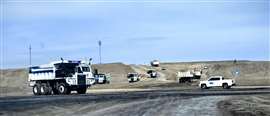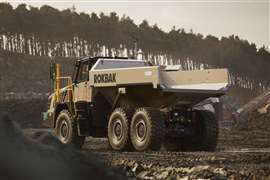Read this article in Français Deutsch Italiano Português Español
Electric sales and globalisation driving Tonly’s growth
07 August 2025
One of the biggest trends, the biggest shifts in the world of construction equipment manufacturers over the last decade has been the globalisation of China-based manufacturers.
 Tonly currently exports to more than 50 countries but is targetting increased global sales. Image: Tonly
Tonly currently exports to more than 50 countries but is targetting increased global sales. Image: Tonly
Tonly, which manufactures construction and mining dump trucks, is certainly no exception to this. International sales have played a part in the OEM climbing to number 39 on the most recent Yellow Table, International Construction’s ranking of the world’s biggest OEMs by sales, although the company feels that there is significantly more global growth to come.
Tonly has already sold over 8,000 units overseas since 2010 and currently exports to more than 50 countries. “In the last two years we also went to the Latin America area, for example, mostly Mexico, Chile and Ecuador,” Mr Yang, deputy general manager of Tonly, told Construction Briefing during a video interview.
Regarding overseas sales Mr Yang reveals that, “South America countries increased very fast this year. We want to develop this very good market in the future. We also want to develop Australia and North America.”
The company’s growth has been mostly driven by strong sales in its domestic market of China with Tonly’s overseas sales accounting for 20% of its total volume, a figure that Mr Yang says is, “not enough.” He added that in the first quarter of 2025 this increased to 30% and the company has set a target of 30–40% in the near future. “We have the strategy to develop the overseas market and enhance the reputation of Tonly,” he said.
A key market for the future is North America, although Mr Yang admits that this is more of a long-term strategy than something that can be acted on immediately – although it is most definitely on the company’s roadmap. “Tonly wants to enter into this market so we must develop all our products accordingly. The customers’ needs, for example, are for more intelligent and safer products... the [truck] payload will also be increased.”
Sales keep on trucking
The China-based OEM has enjoyed a strong start to 2025 with sales in the first quarter increasing by 28% year on year. “This not only reflects Tonly’s strong competitiveness in the industry, but also adaptability to the changes in the economic environment,” he said.
The changes in the economic environment he refers to are, in part, the (relatively) difficult few years that the Chinese economy has had but also the growing demand for electric equipment. Mr Yang says that a good proportion of the company’s growth has come from sales of electric and hybrid equipment.
 Tonly’s deputy general manager, Mr Yang. Image: Tonly
Tonly’s deputy general manager, Mr Yang. Image: Tonly
The company exported more than 62 hybrid trucks to South America and over 100 units to Pakistan this year alone, with total cumulative exports now surpassing 500 units. “The international market for hybrid trucks has increased very fast,” he added.
A statistic that highlights just how much alternative powered equipment has provided rocket boosters to the company’s sales is that approximately 50% of their sales comes from electric and hybrid equipment.
“At present, for the new energy product, the market share is more than 50% of our sales value. And in China we are number one,” reveals Mr Yang. “Most of the Chinese manufactures, their new energy product proportion may be in the 20-25% range but Tonly is more than the half.”
This shift is being driven by regulatory changes and market trends. “We also want, in the future, to develop our new energy products in the overseas market,” he said.
Despite higher upfront costs – “around two times more than the traditional diesel trucks” – the total cost of ownership can be significantly lower. “We save a lot compared to the traditional fuel trucks,” he asserts.
Battery prices are falling steadily, Mr Yang said, noting that today’s battery cost is “only half or one third of what it cost ten years ago.”
Autonomous traction
Autonomy is another key growth area. Tonly already has over 1,200 autonomous trucks in use across regions such as Xinjiang and Inner Mongolia. “The autonomous solution is very important for our customer and us,” said Mr Yang.
Unlike competitors, Mr Yang explained that Tonly’s approach focuses on the system rather than the vehicle itself. “It’s different from Caterpillar and Komatsu. They pay more attention on the product. We keep concentrating on the software, on the platform, on the system.”
He believes this model will be attractive in global markets. “Chinese autonomous solution have more efficiency and lower cost.”
Site conditions and certification requirements have slowed international adoption, but Mr Yang sees long-term opportunity. “Especially in markets where the cost of the driver is very high. They need to reduce the cost of their mining operations.”
Mr Yang also emphasised the importance of smart fleet management. Tonly’s TIMS (Tonly Information Management System) is now in its fourth generation and supports nearly 20,000 vehicles online. “We can track the vehicles’ location and status like the fuel consumption in real time.”
Feedback from the system is also used to improve products. “You feedback to the research and the development centre and improve the quality of the machines and software,” he reveals.
 Around half of Tonly’s sales come from ‘new energy products’. Image: Tonly
Around half of Tonly’s sales come from ‘new energy products’. Image: Tonly
Look to the future
Plans are also underway to localise production, a key part of any OEMs globalisation policy, and there are several countries on Tonly’s radar. “At present Indonesia is the first target and maybe in the future we also consider investing and setting up a factory in South America.”
By 2030, Tonly aims to have 50% of its sales come from international markets. “We explore the overseas markets, and we are planning to localise production, service and the spare parts and also the research and development centre.”
Tonly’s ambitions are clear: to shift from a domestically strong OEM to a truly global player with localised support, smarter systems, and a greener product line. With investments in autonomy, new energy, and fleet intelligence already well advanced, the company appears to be building from a solid foundation.
“We will make more investments in new energy technology and electric autonomous driving systems,” Mr Yang says. “And improve the after-sale service, delivering more value to our users all around the world.”
STAY CONNECTED


Receive the information you need when you need it through our world-leading magazines, newsletters and daily briefings.
CONNECT WITH THE TEAM











